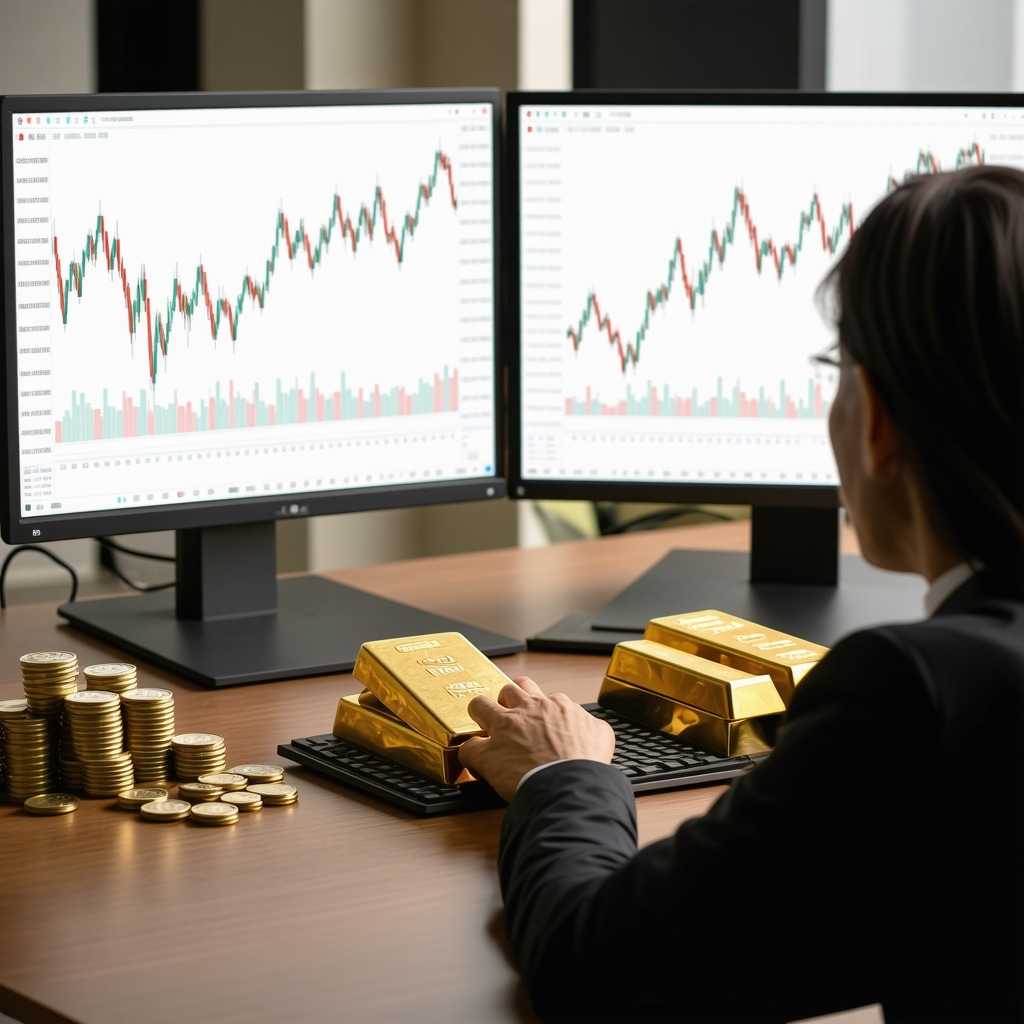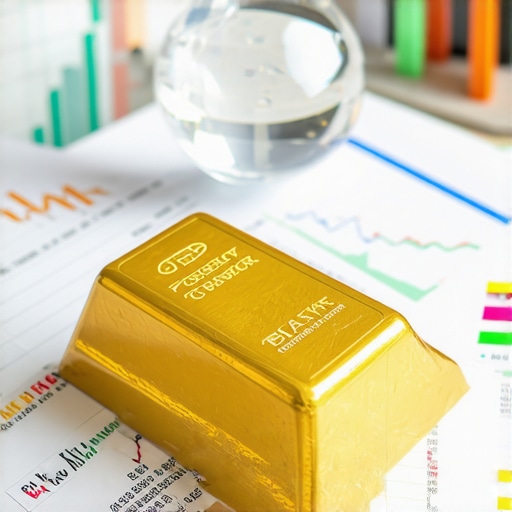Unlocking the Secrets Behind Gold Price Forecasts
Investing in gold remains a timeless strategy for wealth preservation and portfolio diversification. Yet, navigating the complexities of gold price forecasts can be daunting even for seasoned investors. Understanding how to dissect these forecasts is pivotal to making optimal investment moves that align with market realities and your financial goals.
Decoding Market Signals: What Moves Gold Prices?
Gold price forecasts hinge on a myriad of factors including geopolitical tensions, inflation expectations, central bank policies, and currency fluctuations. For example, when inflation surges, gold often acts as a hedge, pushing prices higher. However, interest rate hikes by central banks can dampen gold’s appeal because they increase the opportunity cost of holding non-yielding assets like gold. Monitoring these macroeconomic indicators offers a lens into potential price trajectories.
Which Analytical Tools Best Predict Gold’s Future Value?
Technical analysis tools such as moving averages, Relative Strength Index (RSI), and Fibonacci retracements can reveal momentum shifts and support/resistance levels in gold prices. Meanwhile, fundamental analysis examines supply-demand dynamics, mining outputs, and investment trends in ETFs and futures markets. Combining both approaches often yields a more robust forecast. For instance, this detailed report highlights key drivers that shape near-term gold price fluctuations.
Practical Scenario: Interpreting Conflicting Forecasts
Imagine two expert forecasts: one predicts a bullish gold market due to rising inflation fears; the other warns of a bearish trend given potential Federal Reserve rate hikes. An adept investor weighs these insights by analyzing timing, underlying assumptions, and corroborating them with real-time market data. This nuanced interpretation enables smarter entry or exit points rather than reacting impulsively.
The Role of Gold Demand Trends and Supply Dynamics
Demand from sectors like jewelry, central banks, and technology, along with supply constraints from mining, critically influence forecasts. Understanding these trends helps investors anticipate price movements beyond headline news. For deeper insights, explore how evolving gold demand trends shape market strategies.
Strategizing Your Moves: Balancing Risk and Opportunity
Optimal investment decisions stem from aligning forecast analysis with your risk tolerance and investment horizon. Diversifying across various gold investment vehicles — such as physical bars, ETFs, or futures — can mitigate volatility. For example, physical gold provides tangible security, while ETFs offer liquidity and ease of trading. To grasp these options comprehensively, consider reading types of gold investments and their associated risks.
Have you recently analyzed gold price forecasts for your portfolio? Share your experiences or questions below to foster a community of savvy investors navigating gold markets together.
Source: Insights adapted from the World Gold Council’s comprehensive market analysis, a leading authority on gold investment trends and data.
Embracing Volatility: How I Adjust My Gold Investment Approach
Over the years, I’ve learned that gold markets can surprise even the most seasoned investors. There was a time when I clung too tightly to a bullish forecast during a period of rising inflation, only to see unexpected rate hikes trigger a price dip. This experience taught me the importance of flexibility. Instead of fixating on a single prediction, I started blending forecasts with real-time data and market sentiment to recalibrate my positions. This dynamic approach helps me avoid emotional pitfalls and better seize opportunities.
Understanding the Impact of Global Supply Chains on Gold Prices
Delving deeper, I realized that global supply chains play a crucial role in shaping gold’s price action. Mining disruptions due to geopolitical issues or pandemics can tighten supply, pushing prices upward. Conversely, technological advancements in extraction can boost production, potentially easing price pressures. The role of global gold supply in shaping price trends provides invaluable context to complement traditional demand-focused analyses.
How Can I Balance Physical Gold and Digital Investments for Optimal Security?
This question often nags me when considering portfolio diversification. Physical gold, like bullion or bars, offers tangible security and peace of mind, especially during financial crises. However, digital forms such as gold ETFs or mutual funds provide liquidity and ease of trading without the hassle of storage or insurance. My strategy has been to maintain a core holding of physical gold for stability while using ETFs to capitalize on shorter-term market swings. For newcomers, exploring the best gold ETFs and mutual funds can illuminate this balance.
Reflecting on these experiences, I invite you to share your own gold investment stories or questions. How do you navigate the delicate balance between forecasts and reality? Your insights could help fellow investors refine their strategies and build stronger portfolios.
Harnessing Macroeconomic Indicators: Beyond the Obvious Drivers of Gold Prices
While inflation rates and central bank policies are often spotlighted in gold price discussions, a deeper dive reveals subtler macroeconomic forces at play. For example, the interplay between sovereign debt levels and currency devaluation pressures can amplify gold’s role as a safe haven. Investors should monitor not only headline inflation figures but also real interest rates, which adjust nominal rates for inflation and provide a more precise gauge of gold’s opportunity costs.
Equally critical is the examination of cross-asset correlations. The inverse correlation between the US dollar and gold is a classic relationship, yet emerging markets’ currency dynamics and commodity price cycles introduce layers of complexity. Understanding these nuanced relationships allows for more refined forecasts, especially when global economic landscapes shift unexpectedly.
What Advanced Quantitative Models Enhance the Precision of Gold Price Forecasts?
Quantitative finance offers sophisticated models that blend historical price data with macroeconomic variables to produce probabilistic forecasts. Techniques such as Vector Autoregression (VAR) and machine learning algorithms like Long Short-Term Memory (LSTM) networks can capture temporal dependencies and nonlinear patterns in gold price movements. For instance, a 2023 study published in the Journal of Resources Policy demonstrated how integrating macroeconomic indicators into LSTM models improved predictive accuracy significantly over traditional time-series methods.
Additionally, sentiment analysis drawn from financial news and social media can be incorporated into algorithmic models to reflect market psychology—often a leading indicator of price shifts. These cutting-edge approaches empower investors to parse through noise and focus on statistically significant signals.
Strategic Asset Allocation: Crafting a Resilient Portfolio Amid Gold Market Volatility
Incorporating gold into a diversified portfolio demands a strategic lens that balances risk, liquidity, and return expectations. Beyond the conventional wisdom of allocating 5-10% of assets to gold, advanced investors tailor allocations based on scenario analyses that consider macroeconomic stress tests and geopolitical risk indices.
Dynamic rebalancing strategies that adjust gold holdings in response to forecasted volatility or macro shifts can enhance portfolio resilience. For instance, increasing physical gold exposure during periods of anticipated currency depreciation while favoring ETFs for tactical short-term plays exemplifies a layered approach to risk management.
How Does the Integration of ESG Factors Influence Gold Investment Decisions?
Environmental, Social, and Governance (ESG) considerations have become pivotal in responsible investing, extending into gold markets. Mining practices vary widely in their environmental footprint and ethical standards, influencing investor sentiment and regulatory landscapes. ESG-focused funds now screen gold investments for sustainability metrics, affecting demand and, consequently, price dynamics.
Investors aiming for long-term alignment with ESG principles should evaluate mining companies’ transparency, community engagement, and environmental remediation efforts. This scrutiny not only mitigates reputational risk but also anticipates potential supply disruptions caused by regulatory interventions or social unrest.
For a comprehensive framework, review the World Gold Council’s 2023 ESG Report, which offers in-depth analysis on integrating ESG criteria in gold investment strategies.
Leveraging Real-Time Data Feeds and AI-Driven Insights for Tactical Gold Trading
The acceleration of data availability and computational power has transformed gold market analysis. Real-time feeds on geopolitical developments, trade flows, and macroeconomic releases enable investors to adjust positions rapidly. Coupling this with AI-driven predictive analytics facilitates the identification of emerging trends before they manifest fully in prices.
Trading platforms now embed algorithms that scan thousands of data points, generating actionable signals. However, expertise remains indispensable to contextualize these insights within broader market narratives. As an evolving frontier, the fusion of human judgment and machine intelligence represents the pinnacle of sophisticated gold investment practices.
Ready to elevate your gold investment approach? Engage with our advanced analysis tools and expert commentary to stay ahead in the evolving gold market landscape.
Behavioral Economics: Unearthing Psychological Drivers Behind Gold Price Swings
While quantitative models and macroeconomic indicators form the backbone of gold price forecasting, integrating behavioral economics unveils the psychological catalysts that often precipitate abrupt market shifts. Investor sentiment, herd behavior, and cognitive biases such as anchoring or confirmation bias can amplify volatility beyond what fundamentals suggest. Recognizing these patterns allows for anticipatory positioning ahead of crowd-driven price surges or sell-offs.
Market Microstructure: Decoding Intraday Dynamics That Influence Gold Pricing
Delving into market microstructure offers granular insights into how order flow, liquidity provision, and bid-ask spreads impact gold price formation on a tick-by-tick basis. High-frequency trading algorithms and institutional block trades can trigger short-term price dislocations that, when analyzed correctly, provide tactical entry and exit points. This nuanced understanding complements traditional forecasting methods by illuminating transient inefficiencies.
How Can Behavioral and Microstructural Insights Be Synthesized for Superior Gold Price Prediction?
Fusing behavioral economic theories with market microstructure analytics enhances predictive accuracy by accounting for both human psychology and market mechanics. For example, sudden shifts in sentiment detected via sentiment indices or social media analytics can be cross-referenced with liquidity metrics and order book imbalances to validate the sustainability of price moves. An authoritative resource illustrating this integration is the CFA Institute’s Digest on Behavioral Finance and Market Microstructure, which delineates methodologies for leveraging these complex datasets in asset pricing.
Such a multidisciplinary approach demands advanced analytical capabilities but yields a competitive edge by capturing both the ‘why’ and ‘how’ behind price dynamics.
Leveraging Alternative Data Sources: Beyond Conventional Metrics in Gold Forecasting
In the quest for forecasting refinement, alternative data streams such as satellite imagery of gold mining operations, trade shipment tracking, and even social media analytics provide unconventional but potent indicators of supply disruptions or demand surges. Integrating these datasets via big data platforms enables the detection of subtle market signals often missed by standard reports.
For instance, monitoring night-time luminosity changes around mining regions can reveal operational constraints or expansions ahead of official disclosures, offering anticipatory clues to price movements.
Customizing AI-Driven Forecasts for Individual Investment Profiles
With the proliferation of AI and machine learning, bespoke gold price forecasting models can now be tailored to align with distinct investor risk appetites, time horizons, and liquidity preferences. These models dynamically weigh input variables according to user-defined criteria, delivering personalized probabilistic scenarios rather than one-size-fits-all predictions.
This customization enhances decision-making by contextualizing forecasts within the investor’s unique strategic framework, thereby optimizing portfolio outcomes.
What Are the Challenges in Implementing Multidimensional Forecast Models in Gold Investment?
Implementing complex models that integrate behavioral insights, microstructure data, and alternative datasets poses significant challenges including data quality assurance, model overfitting, and interpretability. Moreover, the rapidly evolving nature of markets necessitates continual model recalibration and robust validation protocols to maintain predictive relevance.
Successful deployment requires interdisciplinary expertise encompassing quantitative finance, data science, and domain knowledge in precious metals markets. For practitioners interested in navigating these challenges, the National Bureau of Economic Research’s working paper on integrating alternative data in financial forecasting offers an in-depth exploration of methodological considerations and practical frameworks.
Engage with these advanced methodologies to elevate your gold investment strategy and harness the full spectrum of analytical insights available. Share your experiences or questions to join a community of forward-thinking investors pushing the boundaries of traditional forecasting.
Frequently Asked Questions (FAQ)
What are the primary macroeconomic factors influencing gold price forecasts?
Key macroeconomic drivers include inflation rates, central bank interest rate policies, currency strength (particularly the US dollar), geopolitical tensions, and sovereign debt levels. These factors affect gold’s appeal as a safe haven and opportunity cost, shaping price trajectories over time.
How can technical and fundamental analyses be combined effectively for gold price prediction?
Technical analysis identifies price momentum, trends, and support/resistance levels through tools like moving averages and RSI, while fundamental analysis assesses supply-demand dynamics, mining outputs, and investment flows. Integrating both offers a holistic view, enabling investors to validate signals and improve timing decisions.
What role does behavioral economics play in understanding gold price volatility?
Behavioral economics uncovers psychological biases such as herd behavior, anchoring, and confirmation bias that drive investor sentiment and can amplify short-term price swings beyond fundamentals. Recognizing these patterns helps anticipate abrupt market moves and avoid emotional trading pitfalls.
How do market microstructure factors influence intraday gold prices?
Market microstructure analyzes order flow, liquidity, bid-ask spreads, and high-frequency trading impacts on price formation. These factors cause short-term price dislocations, creating tactical entry and exit opportunities that complement longer-term forecasting methods.
What advanced quantitative models improve the accuracy of gold price forecasts?
Models like Vector Autoregression (VAR) and Long Short-Term Memory (LSTM) neural networks integrate historical price data with macroeconomic variables and sentiment analysis to capture complex temporal and nonlinear patterns, enhancing predictive precision compared to traditional methods.
How can alternative data sources enhance gold market analysis?
Alternative data—such as satellite imagery of mining activity, trade shipment tracking, and social media sentiment—provides early indicators of supply disruptions or demand shifts often missed by conventional reports, allowing for more timely and nuanced forecasting.
What challenges exist when implementing multifaceted AI-driven gold price models?
Challenges include ensuring data quality, avoiding model overfitting, maintaining interpretability, and continuously recalibrating models in response to evolving market conditions. Successful application demands interdisciplinary expertise in data science, quantitative finance, and precious metals domain knowledge.
How does ESG integration influence gold investment decisions?
ESG considerations affect demand and risk profiles by scrutinizing mining companies’ environmental impact, social responsibility, and governance practices. ESG-aligned investments may anticipate regulatory risks and reputational factors, influencing supply stability and price dynamics.
What are effective strategies to balance physical gold and digital gold investments?
A diversified approach involves holding physical gold for security and stability, particularly during crises, while leveraging digital instruments like ETFs for liquidity and tactical trading. This balance optimizes portfolio resilience and capitalizes on short- and long-term market movements.
How can investors customize gold price forecasts to their unique profiles?
AI-driven models can be tailored to individual risk tolerance, investment horizons, and liquidity needs by weighting input variables accordingly, delivering probabilistic scenarios aligned with personal strategies for more informed decision-making.
Trusted External Sources
- World Gold Council (WGC): Offers authoritative research, market data, and comprehensive reports on gold demand trends, ESG factors, and investment insights, forming a foundational resource for understanding gold’s market dynamics.
- Journal of Resources Policy: Publishes peer-reviewed academic studies on resource economics, including advanced quantitative modeling of gold price movements and integration of macroeconomic indicators.
- CFA Institute: Provides in-depth analyses on behavioral finance and market microstructure, valuable for comprehending psychological and mechanical drivers behind gold price fluctuations.
- National Bureau of Economic Research (NBER): Features working papers on financial forecasting methodologies, including challenges and frameworks for integrating alternative data in asset price predictions.
- Goldhub by World Gold Council: Delivers detailed ESG reports and sustainability analyses specifically tailored to the gold mining sector, guiding responsible investment decisions.
Conclusion: Synthesizing Expert Insights for Mastering Gold Price Forecasts
Expert gold price forecasting demands a multifaceted approach that blends macroeconomic analysis, technical and fundamental methodologies, behavioral insights, and cutting-edge quantitative models. Recognizing the nuanced interplay of global supply chains, investor psychology, and market microstructure enriches understanding beyond conventional metrics. Incorporating alternative data sources and tailoring AI-driven forecasts to individual investment profiles further refines predictive accuracy and strategic agility.
Moreover, integrating ESG considerations aligns investment decisions with evolving ethical standards and regulatory landscapes, ensuring sustainability and mitigating risks inherent in gold markets. Balancing physical and digital gold holdings strategically enhances portfolio resilience amid volatility.
Ultimately, mastering gold price forecasts requires continuous learning, flexibility, and the synthesis of diverse analytical perspectives. We encourage you to apply these expert strategies, share your experiences, and explore related advanced content to elevate your gold investment acumen and confidently navigate the 2029 market landscape.











I really appreciate how this post emphasizes the importance of blending technical and fundamental analysis when forecasting gold prices. From my experience, relying solely on technical indicators like moving averages can sometimes lead to false signals, especially during volatile market phases. Incorporating supply-demand dynamics and macroeconomic factors provides a more holistic view. I’ve also found that understanding investor sentiment through social media sentiment analysis can give early clues about market shifts, which is particularly useful in the current digital age. That said, I wonder, how do others here balance the use of AI-driven models with traditional analysis? Do you find that automated forecasts tend to align well with real-time market intuition, or do they sometimes lead you astray? Given the rapid evolution of market microstructure and alternative data sources, continuous learning seems essential for remaining ahead of the curve. Would love to hear your strategies for integrating these diverse insights into a cohesive investment decision framework.
This post really highlights how crucial it is to take a multi-faceted approach when analyzing gold prices. I’ve found that while technical tools like RSI and Fibonacci levels offer valuable insights during stable periods, they can sometimes give misleading signals in highly volatile environments—especially when macroeconomic news suddenly shifts sentiment. That’s why I also pay close attention to real-time data feeds and market microstructure signals, which can provide a more immediate snapshot of market psychology and liquidity trends. I’m particularly interested in how others integrate behavioral economics into their forecasting models—do you use sentiment analytics or social media data to gauge investor mood? Personally, I think coupling these psychological insights with traditional macro indicators enhances the robustness of forecasts. Have any of you experimented with AI models that incorporate alternative datasets for real-time decision making? I believe the key to successful gold investing in today’s complex environment is remaining flexible and continuously updating your analytical framework to include new sources of information. Would love to hear about your experiences or tools that have helped you stay ahead.